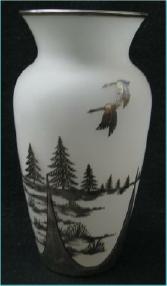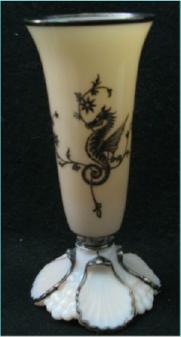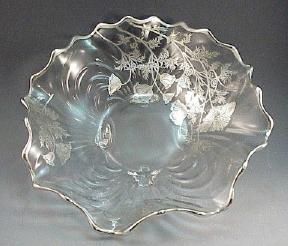Silver, Gold & Platinum Decorations on Cambridge Glass
by Lorraine Weinman
January 2007 - Issue 403
One of the most popular NCC events is the November program and quarterly meeting and this year was no exception. On Saturday, November 4, 2006, members convened in Cambridge, Ohio, at the Holiday Inn. Earlier in the day, many arrived at the Museum to take part in a mini flea market of Cambridge Glass. David Ray had suggested that members should bring glass to sell and the auditorium at the Museum was filled with vendors and buyers. It was a popular addition.
With the opportunity to visit and view the program glass, people arrived prior to the dinner. After the annual November meeting, Lynn Welker took the floor to lead the program.
 A display of Cambridge glass with silver overlay, platinum and gold decoration stretched the length of the room.
A display of Cambridge glass with silver overlay, platinum and gold decoration stretched the length of the room.
Lynn began by asking how many people were not familiar with the process of applying the silver, to which a sea of hands immediately was seen. Several years ago, a Convention speaker had given a technical presentation on this process. Lynn referred to that event and was now prepared to lead the group through a more basic presentation, understandable and enlightening to the audience.
Glass companies did not have the chemical capability to apply silver to glass. Lynn explained that it is an electro-plating process. It was done by silver decorating companies. The companies that did this work were primarily in Connecticut, Rhode Island, Massachusetts, New York and Maryland, with Lotus of Barnesville, Ohio, being a fluke because of its location. Rockwell Company and Silver City were often mentioned as major decorators.
Lynn mentioned that the process of applying silver was done in several ways. The basic explanation of the process is that something is put on the glass first, like copper or brass. Nine out of ten times the pattern was etched lightly onto the piece first and then through a chemical electroplating process the silver was made to stick to the glass – made to stick to the copper or brass design on the glass. If you look through a crystal piece of glass and see
 white, it actually was etched and the silver was made to adhere to that etch. Lynn told us that this explanation was a very simplified version of what happens because it is a more complicated process.
white, it actually was etched and the silver was made to adhere to that etch. Lynn told us that this explanation was a very simplified version of what happens because it is a more complicated process.
In 1998, convention speaker, Dr. David E. Fairbrothers delved into the process detailing the use of acid baths and flux. As an authority in the field, he was able to describe the process in technical terms.
Continuing, Lynn said that the silver was put all over the piece, but only stuck to the pattern. Now, not all glass was done this way. Something similar was done by the Cambridge Glass Co. on their platinum decorated items. Glass companies were capable of doing that. It was not as involved a process. A lady who worked in the decorating department once told Lynn that they "painted" the platinum on and then it was fired. This was much like the process with the gold. Platinum can be identified because it has a gray tone to it ... it never tarnishes. Cambridge did platinum work. Some platinum was put on like a silk screen process – like a stencil.
Rockwell Company was the highest quality of the silver decorating companies. Besides Cambridge Glass, they also worked on Tiffany, Steuben, LaSalle, Heisey, Duncan Miller, Tiffin and Fenton. Rockwell is easy to identify in three ways. You can tell by its detail. After they put the silver on the item, they had an artist take a stylus and cut the designs. Also, Rockwell is acid signed with a shield with the word Rockwell at the top of it. A third identifying characteristic is that they often used little enamel numbers placed on the piece on the bottom. Rockwell tended to number a lot of their pieces. Later, Lynn stated that another way to tell if a piece was done by Rockwell is that Rockwell was a really thick plating of silver. Both photographs above are examples of Rockwell decorations on Cambridge glass.
As Lynn then proceeded to walk along the display, he described each piece and gave further information regarding the decoration. He often discussed the company which did the work and more detail about how it was done and likenesses and differences to the Rockwell Company. He discussed the Kobe silver design which has a very oriental look. One example of this had a
 rickshaw and water bearer on it. There was a cocktail shaker with a handle with the Santa Maria in silver on it which also has Hawkes cutting done on it. Often Hawkes did the cuttings and sometimes they signed the piece as was the case with a one pound candy jar in Light Emerald that was displayed. Most Crown Tuscan is Rockwell decorated. The dragon – or we often call it the seahorse – is one such decoration.
rickshaw and water bearer on it. There was a cocktail shaker with a handle with the Santa Maria in silver on it which also has Hawkes cutting done on it. Often Hawkes did the cuttings and sometimes they signed the piece as was the case with a one pound candy jar in Light Emerald that was displayed. Most Crown Tuscan is Rockwell decorated. The dragon – or we often call it the seahorse – is one such decoration.
There was an example of Wallace silver. Wallace did not do silver overlay, but they did put edges on. Some Caprice was done by Rockwell, but most was done by other silver companies like Silver City. It is not the same silver as Rockwell, but it often says Sterling on it. Rockwell didn’t say Sterling. If it says Sterling on the piece, it probably is not Rockwell.
Lotus bought all kinds of glass and worked on it often using the same pattern. It is nice silver but may appear a little "pebbly" or grainy – Rockwell looks more polished. Silver City, of Meriden, Connecticut, decorated many pieces of Caprice, as seen at right.
The early sterling work is seen on Cambridge opaques. It appears as a very thin silver and some looks like silk screening and other like hand painting. It is possible that Cambridge Sterling silver may actually be white gold encrusted in some cases. Most of Cambridge’s silver overlay glass was done in the early '30s to early '40s.
Finally, Lynn, Rich Bennett and Mike Neilson spoke about some do’s and don’ts of cleaning silver overlay on glass. A question and answer period followed and everyone was encouraged to look at the display. This was an excellent presentation. Thanks to David Ray for arranging it and to Lynn and all the contributors to adding to our education regarding this beautiful glass.
